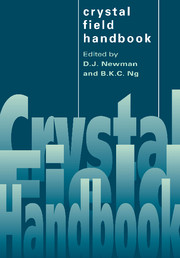Book contents
- Frontmatter
- Contents
- List of contributors
- Preface
- Introduction
- 1 Crystal field splitting mechanisms
- 2 Empirical crystal fields
- 3 Fitting crystal field parameters
- 4 Lanthanide and actinide optical spectra
- 5 Superposition model
- 6 Effects of electron correlation on crystal field splittings
- 7 Ground state splittings in S-state ions
- 8 Invariants and moments
- 9 Semiclassical model
- 10 Transition intensities
- Appendix 1 Point symmetry
- Appendix 2 QBASIC programs
- Appendix 3 Accessible program packages
- Appendix 4 Computer package CST
- Bibliography
- Index
6 - Effects of electron correlation on crystal field splittings
Published online by Cambridge University Press: 10 December 2009
- Frontmatter
- Contents
- List of contributors
- Preface
- Introduction
- 1 Crystal field splitting mechanisms
- 2 Empirical crystal fields
- 3 Fitting crystal field parameters
- 4 Lanthanide and actinide optical spectra
- 5 Superposition model
- 6 Effects of electron correlation on crystal field splittings
- 7 Ground state splittings in S-state ions
- 8 Invariants and moments
- 9 Semiclassical model
- 10 Transition intensities
- Appendix 1 Point symmetry
- Appendix 2 QBASIC programs
- Appendix 3 Accessible program packages
- Appendix 4 Computer package CST
- Bibliography
- Index
Summary
As was pointed out in Chapter 2, a considerable number of high-precision optical absorption and fluorescence spectra for lanthanide ions in ionic host crystals have been gathered since 1960. Crystal field fits, such as those described in Chapter 4, to the 100+ lowest-lying energy levels in lanthanide ions are generally good. However, fits to some particular ‘problem’ multiplets are invariably poor, e.g. the 3K8 multiplet of Ho3+, the 1D2 multiplet of Pr3+, and the 2H11/2 multiplet of Nd3+. In addition, some of the variations in the values of fitted parameters across the lanthanide series cannot be understood in terms of differences in ion size, or in terms of the ionic dependence of site distortions.
Problems with the one-electron crystal field parametrization also occur in fitting the energy levels of actinide and 3d transition metal ions. However, for these ions, the problems are not so easy to characterize as they are in the case of lanthanides. For this reason, while the main focus of this chapter is on the analysis of specific inadequacies of the one-electron model of lanthanide crystal fields, the conceptual aspects of this analysis should be understood as being relevant to all magnetic ion spectra.
Some of the difficulties found in fitting one-electron crystal field parameters can be associated with the use of inaccurate free-ion basis states resulting from the use of an inadequate parametrization of the free-ion Hamiltonian.
- Type
- Chapter
- Information
- Crystal Field Handbook , pp. 120 - 139Publisher: Cambridge University PressPrint publication year: 2000
- 2
- Cited by

